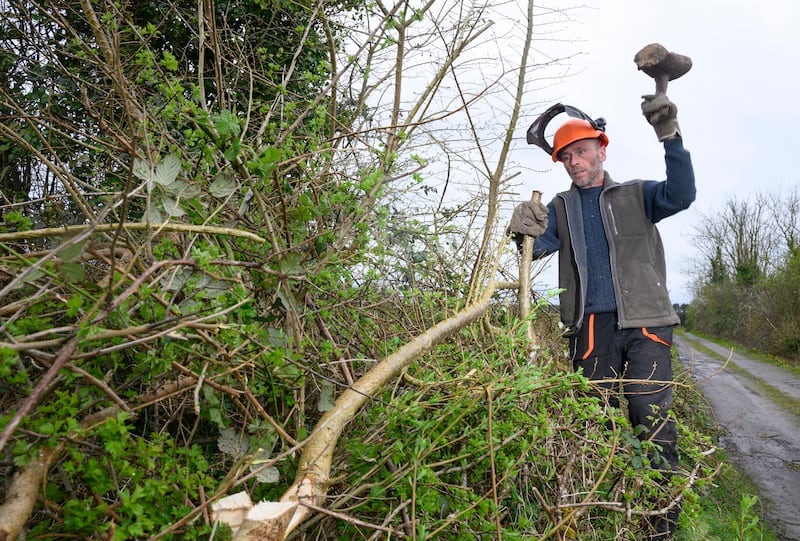I was born in the UK. I moved to Co Mayo in 2000 and I’ve been here since.
Hedgelaying was something my grandfather did, he was a farmworker. When he passed away, I started looking into it. I found the Hedgelaying Association of Ireland and got my accreditation.
Hedgerows are there for two main reasons: to divide land between owners and to divide fields to keep the stock in. An unlaid hedge can become gappy. Hedgelaying is a way of managing hedgerows.
What we do is cut a sharp angle down the main stem of the tree. We cut through about three quarters of the way so that it can be folded over about 45 degrees.
The cut in the main stem is called a pleacher. It looks quite shocking, but there is enough for the sap to rise back up in the spring. Regrowth comes at the bottom, so you are thickening the hedge from the base, which keeps the small lambs in.
The weave or binding we do on the top of the hedge is hazel or willow – any nice long, straight, flexible rods. It holds the hedge together until the regrowth. A good hedge is stock-proof.
Hedgelaying also rejuvenates the tree. We remove a lot of the branches so the hedge is quite narrow when it’s finished. I like the hedge to look neat, aesthetically pleasing. I’m quite fussy.
Hedgelaying attracts wildlife back into the hedge. The hedge is a safe place for them to be. It provides shelter and protects biodiversity. Hedges provide corridors for them to move across land. You’ll never see a mouse springing across a field, it’s too dangerous. Hedges are a highway for wildlife.
About 6.9 per cent of the total land in Ireland is hedges – that sequesters a lot of carbon. You can make a living from hedgelaying when there are schemes up and running. My customers are mostly farmers and landowners. A lot of them are interested in farming in a nature-friendly way. If they get a grant, they are happy with the job being done for nothing, or they might have to chip in a small amount.
You can start working on hedges at the beginning of September and you have to stop on the last day of February. When everybody moves indoors for winter, that’s when we start – me and my son Toby. He’s 19. We live in the van together. We park next to the hedge and we work on the hedge from first light until dusk. Then we have to get everything dried up for the morning. We have a little wood-burning stove in the van and we have to work hard to get everything dry for the next day. It’s tough.

It’s quite nomadic, because we are just living in the fields and sleeping in the van next to the hedge. You become at one with the hedge really. Things are pretty simple – we are pretty much just using axes and slash hooks and we use a chainsaw for the bigger stuff. It’s physically demanding. You do put your day’s work in and sleep well at night.
There is some peace with it. You are never far away from nature. The nights are long. We cook and sit down in the evenings and carve spoons and amuse ourselves. We’ve only got two gas rings, so it’s always a two-pot meal. On one job, the landowner came and gave us venison, so we were literally eating the venison in the field where it lived its life.
So many people say to me, my son wouldn’t do that with me, but we’ve always got on. We don’t fall out, the van’s too small for that. I’m always happy to have a good stretch of hedge to get stuck into, because you’ve secured employment for a while. One we did recently in Roscommon was 350 metres long and it took around three and a half weeks.
It’s nice to be in one place for a while, but it’s also nice to do the last cut and the job is completed. You just stand back and think, that’s a great achievement, that’s a great corridor for wildlife. It’s like opening a new motorway.
In farming, there should be a responsibility to work with nature. When a hedge is hundreds and hundreds of metres long, I suppose people just don’t have time and they bang in a few posts and put wire up and ignore the hedge for its benefits. I think a bit of time and consideration for nature is extremely important. It feels good to know I am doing something for the environment. You know you are going to thicken up the hedge and wildlife will move into it and it will create a safe place for nesting birds as well.
The rest of the year, we are carpenters and joiners. It’s nice to have something to fall back on, but it’s also nice to have a change and do something environmental. When I started off as a carpenter, my grandfather was always asking what I did at work. If he were alive, I know he would come and see what we were up to. He would have been delighted with it. – In conversation with Joanne Hunt









